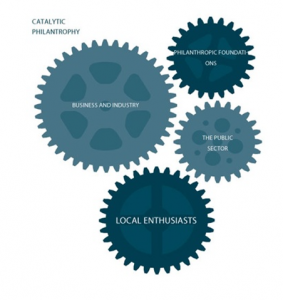
Image Source: Huffington Post
The use of cultural appropriation in marketing and branding is becoming a trend among businesses as stated in Karina’s blog post2. Her post discusses Ungava and Urban Outfitter’s usage of the cultural appropriation of North American First Nations. Ungava, a Canadian gin company from southern Quebec, has drawn themes into its marketing from the Inuit First Nations in Quebec. Ungava has used “Asian women dressed in skimpy parkas” as a way of advertising for the gin, along with a random, meaningless mix of Inuktitut syllabics, and Inuit imagery. The vice-president for economic development at Makivik Corp (who represents Quebec’s Inuit), Andy Moorhouse, stated that he was offended by Ungava’s usage of Inuit cultural appropriation.1 Meanwhile, in 2012, Urban Outfitters has been using the Navajo Nation’s name to brand a whole line of products, leading to a lawsuit that the Navajo Nation filed against Urban Outfitters. Although the Indian Arts and Crafts Act and federal trademarks still stand, the court ruled in favour of Urban Outfitters stating that the use of Navajo is a “descriptor of style rather than origin”, therefore not an infringement.4
I totally agree with Karina’s point2 that this kind of cultural appropriation could result in false stereotypes of a culture and is profoundly disrespectful to the culture. As Porter has mentioned, companies that create economic and societal value have a competitive advantage.3 Ungava’s indiscriminate usage of Inuit themes wrecks not only the societal value that the company is supposed to have with the Inuit communities, but also the trust between the company and the Inuit communities. With Urban Outfitter’s case, the firm might create a totally different, unrealistic image of the Navajo Nation. I believe that the inappropriate exploitation of cultural appropriation is not only no socially responsible, but also unethical. I see this as a way for companies to exploit a segment’s disadvantage of not knowing a particular culture. Governments should have a way of regulating this because the values within the traditions and themes in culture could easily be forgotten and be replaced with the value the marketers re-attached with the traditions and themes. The new portrayals may also create negative connotations to that particular culture, turning a good image to an evil image, or a serious image to an indiscriminate image.
Word Count: 377
References
Hamilton, Graeme. “Inuit Say Gin Maker Needs to Compensate for Appropriating Culture.” National Post, 2 Oct. 2016, news.nationalpost.com/news/canada/inuit-say-gin-maker-needs-to-compensate-for-appropriating-culture. Accessed 13 Nov. 2016.
Kong, Karina. “Why Businesses That Profit off the Culture of Others Are Not Socially Responsible.” Karina Kong’s Blog, UBC Blogs, 30 Oct. 2016, blogs.ubc.ca/kkong/2016/10/30/why-businesses-that-profit-off-the-culture-of-others-are-not-socially-responsible/. Accessed 13 Nov. 2016.
Porter, Michael E., and Mark R. Kramer. “Creating Shared Value.” Harvard Business Review, PDF ed., 2011, pp. 62-77.
Randolph, Imani. “Fashion’s Appropriation of Navajo Culture Has Been Deemed Legal.” Fader, 15 July 2016, www.thefader.com/2016/07/15/urban-outfitters-navajo-nation. Accessed 13 Nov. 2016.
Image Source
“Promotional Material from Ungava’s Facebook Page.” Huffington Post, 15 Sept. 2016, www.huffingtonpost.ca/2016/09/15/ungava-gin-inuit-cultural-appropriation_n_12017002.html. Accessed 13 Nov. 2016.

